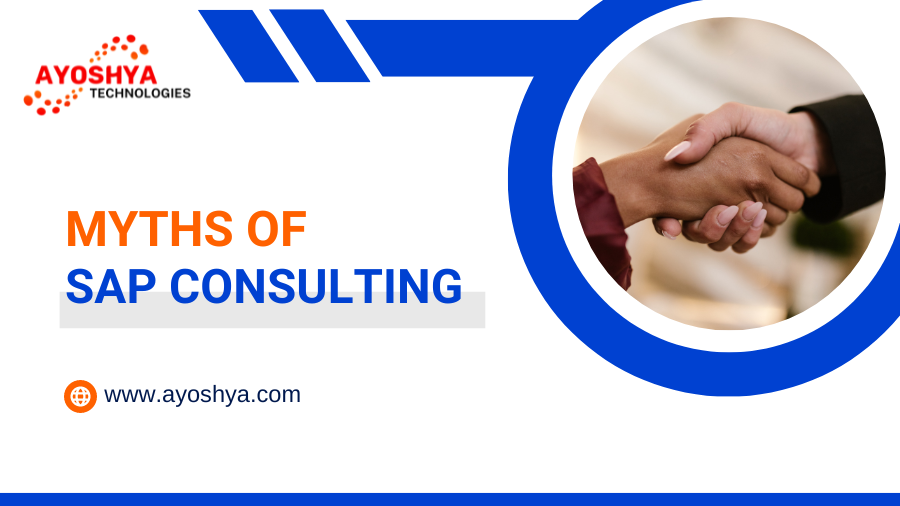Debunking the Myths of SAP Consulting and Unveiling Unforeseen Challenges
In the bustling marketplace of enterprise software, whispers of SAP consulting paint a picture of smooth implementations, skyrocketing productivity, and blissful operational harmony. But behind the alluring brochures and captivating case studies, a more nuanced reality unfolds. This blog serves as your trusted guide, peeling back the facade of Myths of SAP Consulting and unearthing the unforeseen challenges that lie in wait on the SAP consulting journey.
Myths of SAP Consulting #1: SAP is a Magic Fix for All Business Ailments:
Truth: While SAP boasts powerful functionalities, it’s not a magic elixir. Implementing SAP without thoroughly analyzing your unique business needs and processes can lead to a mismatch, resulting in wasted resources and frustrated users. Remember, SAP is a complex system, and successful implementation demands careful customization and integration with existing infrastructure.
Unforeseen Challenge: Scope creep – As implementation progresses, you might discover additional functionalities you ‘need,’ ballooning the project scope and budget.
Myths of SAP Consulting #2: SAP Consultants are Wizards Who Solve All Your Problems:
Truth: While SAP consultants possess deep expertise, they’re not omnipotent oracles. Successful implementations require active collaboration and clear communication between your team and the consultants. Be prepared to share detailed insights into your workflows, document processes meticulously, and provide ongoing feedback to ensure the solution aligns with your vision.
Unforeseen Challenge: Communication roadblocks – Misunderstandings between your team and the consultants can lead to missed requirements, inefficiencies, and delays. Prioritize clear communication channels, regular meetings, and active participation from all stakeholders.
Myths of SAP Consulting #3: Implementing SAP is a Smooth, Linear Ride:
Truth: Prepare for a rollercoaster, not a leisurely train journey. SAP implementations are complex undertakings, often encountering unforeseen obstacles, resistance from users, and data migration hiccups. Expect bumps along the road, embrace agility, and adopt a flexible mindset to navigate unforeseen challenges.
Unforeseen Challenge: User resistance – Change can be daunting, and employees might resist adopting new systems. Address concerns proactively, provide comprehensive training, and incentivize early adopters to foster a culture of acceptance.
Myth #4: Once Implemented, SAP Runs on Autopilot:
Truth: SAP, like any robust system, requires ongoing maintenance and optimization. Allocate resources for continuous system updates, user support, and performance monitoring. Remember, your business evolves, and your SAP environment should adapt alongside it.
Unforeseen Challenge: Skill gap – As your SAP landscape grows, you might lack the in-house expertise to manage it effectively. Invest in upskilling your existing team or consider partnering with managed service providers to ensure ongoing system health and optimization.
Myth #5: SAP Consulting is an Expensive Luxury Only Large Enterprises Can Afford:
Truth: While extensive implementations can reach six figures, smaller-scale solutions and phased approaches are accessible even for smaller businesses. Research available options, explore flexible financing models, and prioritize ROI-driven initiatives to leverage the potential of SAP without breaking the bank.
Unforeseen Challenge: Underestimating costs – Hidden costs like data migration, customization, and ongoing maintenance can add up. Factor in all potential expenses to create a realistic budget and avoid financial surprises down the line.
Beyond the Myths: Unveiling the Path to Success:
Debunking the myths doesn’t negate the immense value SAP can bring to your business. But achieving success demands a realistic approach, informed by both truths and potential challenges. Here are your guiding principles:
- Conduct a thorough business needs analysis: Understand your goals, processes, and existing infrastructure before diving into SAP.
- Choose the right partner: Select experienced consultants who understand your industry and culture, prioritizing clear communication and collaborative engagement.
- Prepare for change management: Foster user buy-in, provide robust training, and address resistance proactively to ensure smooth adoption.
- Embrace agility and be prepared to adapt: Unexpected issues may arise; maintain a flexible mindset and adjust your approach as needed.
- Invest in ongoing maintenance and optimization: Allocate resources for updates, support, and performance monitoring to ensure the long-term health of your SAP environment.
The Unforeseen Triumph: Building Your SAP Oasis:
By navigating the myth-laden landscape with clear eyes and a well-defined strategy, you can transform the challenges of SAP consulting into stepping stones to success. Remember, a successful SAP implementation is not a solo endeavor; it’s a collaborative journey driven by informed decision-making, meticulous planning, and a culture of learning and adaptation. So, embark on your SAP odyssey with realistic expectations, strategic foresight, and unwavering commitment. With the right approach, the myths fade away, and your SAP oasis awaits, brimming with streamlined operations, enhanced productivity, and a future propelled by data-driven excellence.
You may be interested in:
Oracle Consulting: the Power of Digital Transformation
Top 10 OData Benefits for Developers & Businesses



